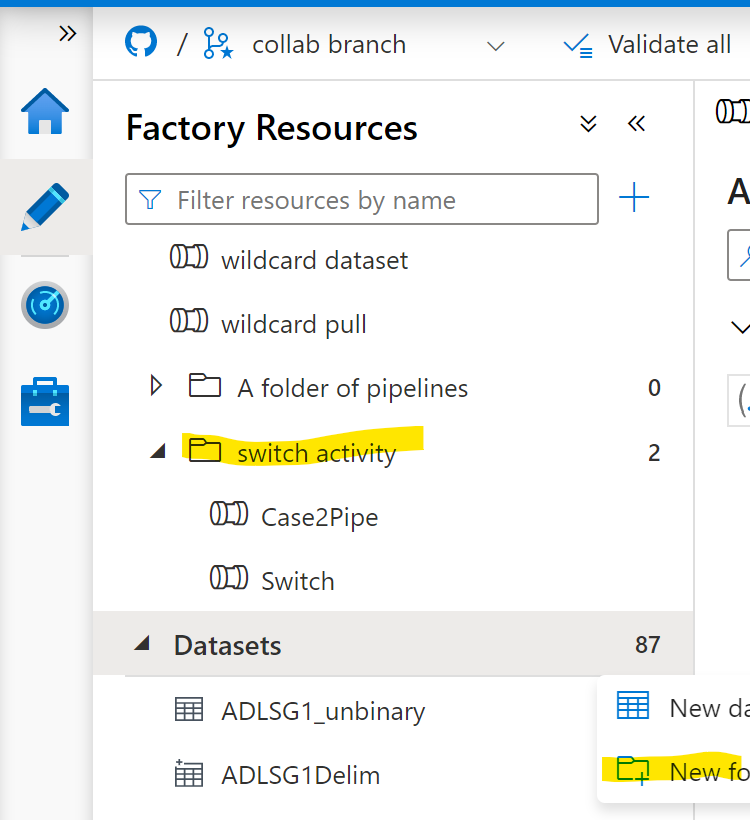Hello @Stephen Thomas Wheeler ,
Thanks for the question and using MS Q&A platform.
As I understand, you are asking for advice or comments on whether to use a single Azure Data Factory, or multiple, in regards to "separation of concerns". I am not aware of a best practice guide on this topic, but one may yet exist.
I would like to make you aware of some options and ramifications of choosing one or the other approach. The chief option you may or may not be aware of, is pipeline folders. For ease of organization, you can create folders to organize the assets in a single Data Factory.

The ramifications include:
Keeping linked services synchronized. Naturally, data is ingested / ingressed for a purpose. This purpose may be embodied by a pipeline in another Factory. If for some reason, a change is made to the location of data, a change will need to be made in the Linked Service or Dataset. With multiple factories, both will need a copy of the Linked Service / Dataset. One for depositing, the other for reading. Should only one of these be changed, the other will not work properly. Using Azure Key Vault may help to some extent. If there is only a single Factory, you can re-use the Linked Service / Dataset in both the ingress and the processing piplines.
Trigger dependency and Executing child pipelines
. You may want to have the success of one step / business process / pipeline cause another step / business process/ pipeline to run. Naturally, this is easier when everything is inside the same Factory. This allows for use of Execute Pipeline activity. Execute Pipeline activity cannot be used on a pipeline is a different Factory. There are ways to cause pipelines to run in other factories, but that is more for exceptions than general use.
You can set up Tumbling Window Trigger dependencies, where one pipeline runs if and only if another pipeline was run successfully. This only works within a Data Factory, there are no cross-factory options.
Self-Hosted Integration Runtime (SHIR) complications
. Only one instance of SHIR can be running on a machine at a time. This SHIR is 'owned' (registered to) by exactly one (1) Data Factory. This SHIR can be shared with other factories (See Shared SHIR document). However when CI/CD , multiple environments, and delployment pipelines are involved, the issue becomes much harder to maintain. A recommended practice, when a SHIR is shared with many factories and environments, is to have a Factory dedicated to owning the SHIRS independent of environments.
You need to be mindful of the workload placed upon a SHIR. With multiple factories, that is like an entire office sharing a single printer. Same amount of work, but more coordination and monitoring. Azure Monitor may help.
Cost is not really a concern. There is a small bit of overhead, but unless you have 100 factories, it is insignificant to data processing cost.
There are limits to how much can go into a Factory, but there are subscription limits too. See link. Whether you even get close depends upon your organization. The most significant and relevant ones in my opinion are:
- Concurrent number of data flow debug sessions per user per factory: 3 (hard limit)
- Total number of entities, such as pipelines, data sets, triggers, linked services, Private Endpoints, and integration runtimes, within a data factory: 5000 (soft limit)
But I must ask, what are you really trying to accomplish? Is it limiting permissions, like only certain people should be able to edit pipeline X? That is a much trickier task to accomplish. If you seek to limit permissions per separation of concern, then you should use separate Data Factories. There is a way to make custom roles for specific assets, but it is difficult and not easy to maintain.
When it comes to Git / ADO integration and keeping code in repository, some options open up. You can give each separation of concern its own branch, and merge them before publish/deploy. Remember from my first point, the advantage of de-duplication of Linked Service/ Datasets. If each branch makes their own differently named copy, you lose some of that.
There is another feature you may find useful, especially for sorting your concerns. Annotations (pipelines) and User Properties (activities). These are more useful for tagging / documentation / notes. Annotation shows up in Monitoring and can be used for filtering.

(posting before I lose stuff)
Please do let me if you have any queries.
Thanks
Martin
------------------------------------------
- Please don't forget to click on
 or upvote
or upvote  button whenever the information provided helps you. Original posters help the community find answers faster by identifying the correct answer. Here is how
button whenever the information provided helps you. Original posters help the community find answers faster by identifying the correct answer. Here is how - Want a reminder to come back and check responses? Here is how to subscribe to a notification
- If you are interested in joining the VM program and help shape the future of Q&A: Here is how you can be part of Q&A Volunteer Moderators